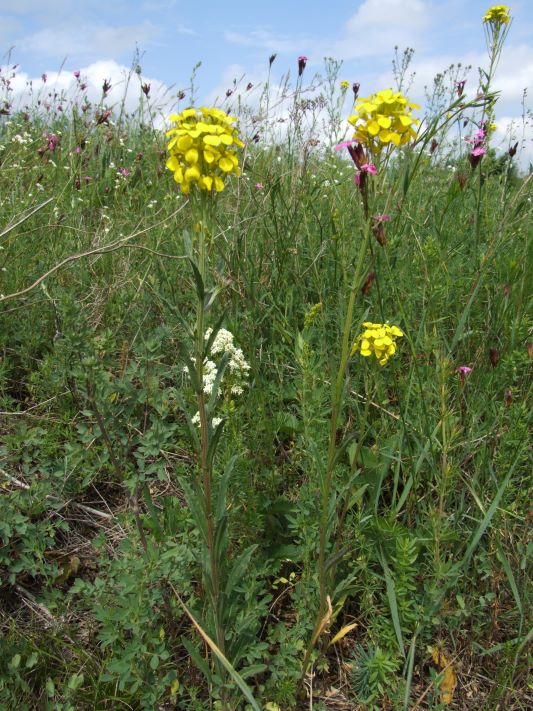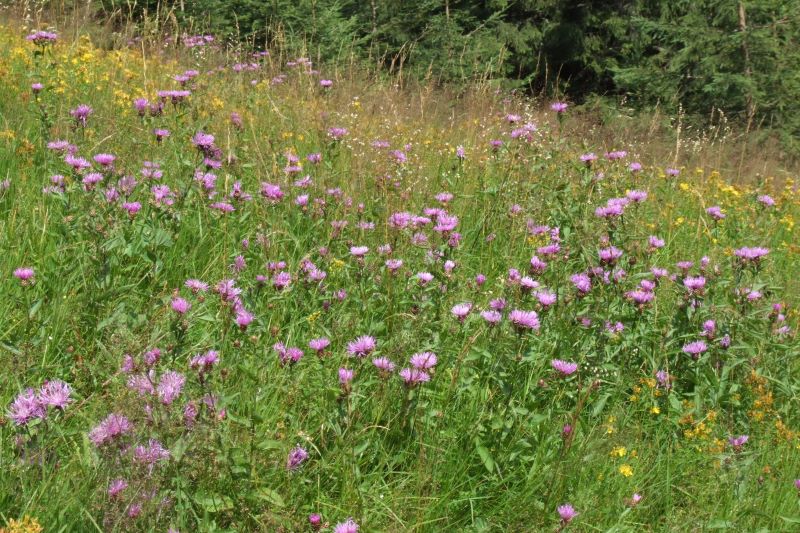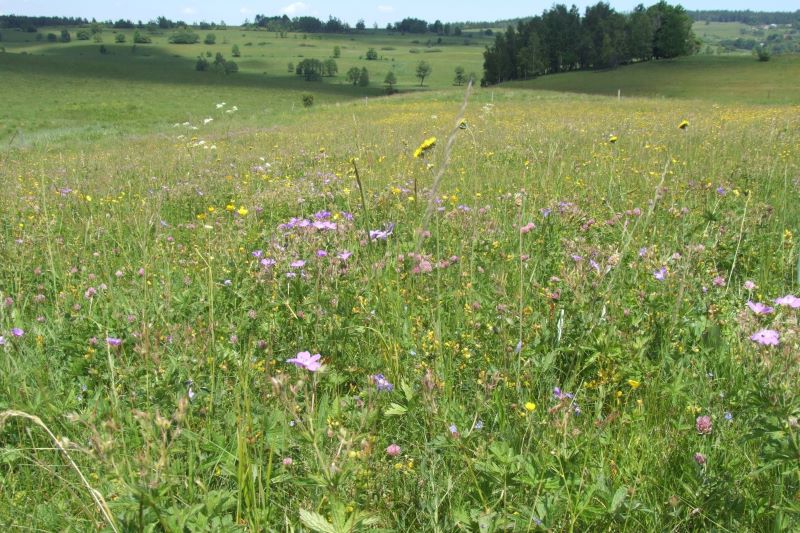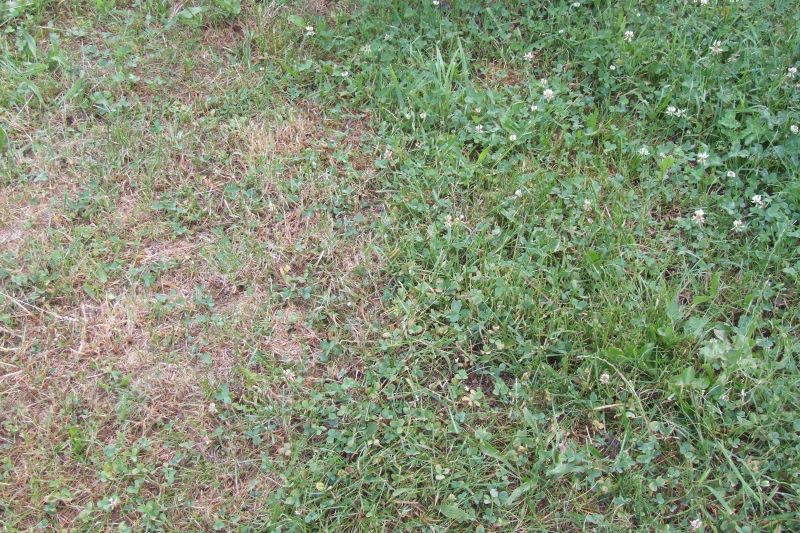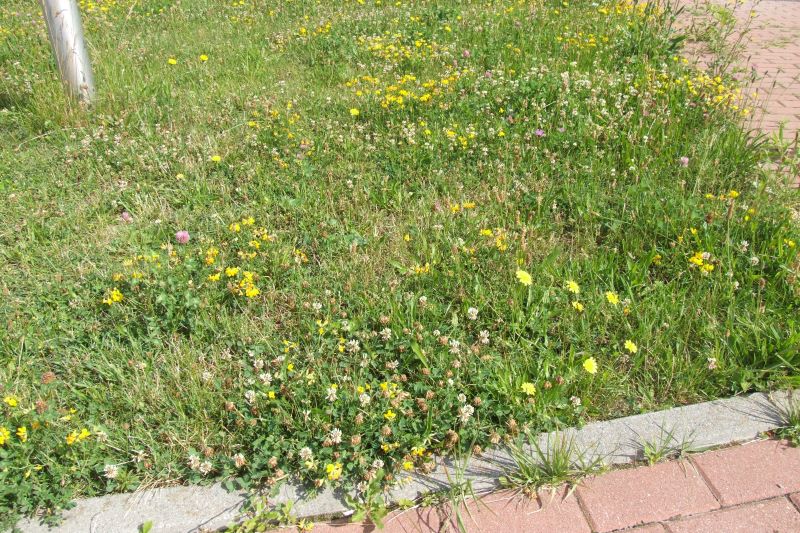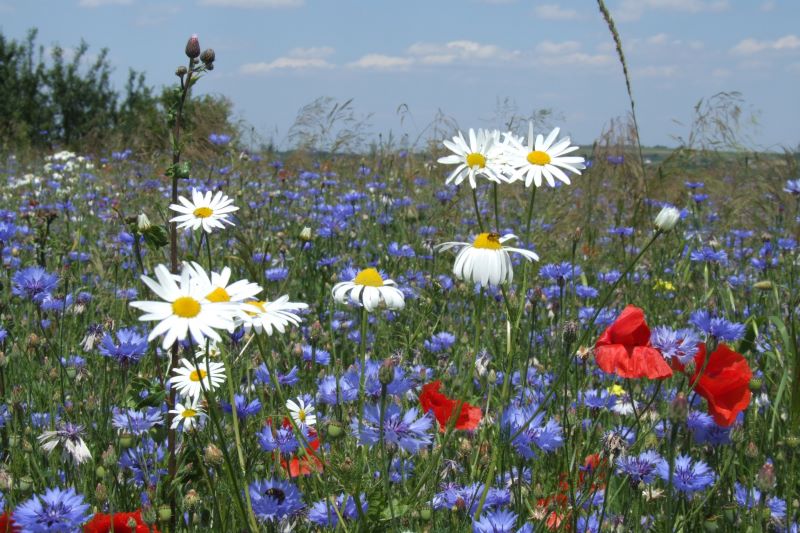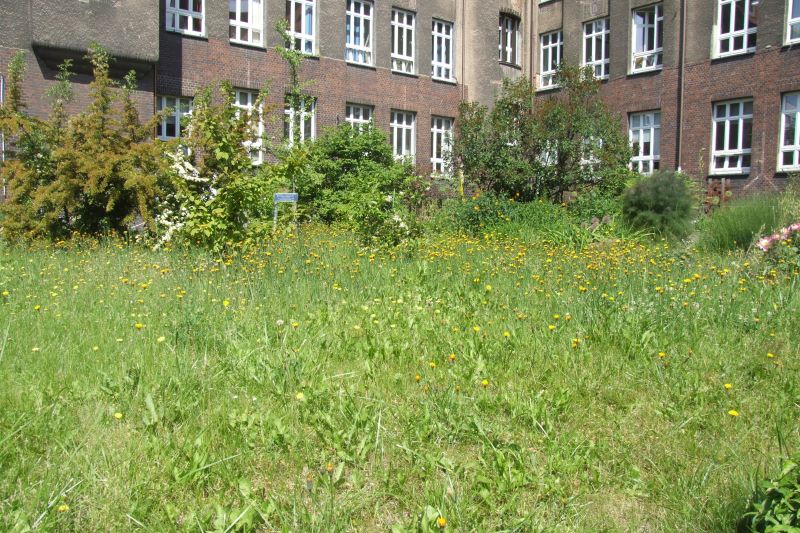Semi-natural plant communities the composition of which can be a model for arranging lawns in cities | Photo by Teresa Nowak
Every year, when the plants start to bloom, the subject of lawn mowing returns – an issue that constantly arouses much emotion. Teresa Nowak, PhD from the Faculty of Natural Sciences of the University of Silesia talks about whether and when green areas should be mowed.
WERONIKA CYGAN: What is the truth? Should we mow the grass or not? What is the healthiest approach for humans and the environment?
TERESA NOWAK, PhD: This topic is indeed very often taken up in online discussions, both on information websites and thematic forums. Preservation of plant formations dominated by or with a significant share of grasses in a proper condition – regardless of whether they are semi-natural or completely man-made – depends on the periodic removal of biomass. If we are talking about such a form of green areas, then the question of whether they should be mowed should be answered in the affirmative. Without such treatment, plants do not have optimal conditions for development, and some are even eliminated.
The prototypes of an urban lawn can be, in a sense, communities of non-forest vegetation, spontaneously developed, such as: xerothermic grasslands, fresh meadows or mountain meadows and bent grass meadows used extensively. While examining them, we can see that the felt created by dry grasses from previous growing seasons makes vegetation difficult for the plant species that build these communities. This is one of the factors indicated as a threat to the species diversity of the above-mentioned plant communities, and mowing is mentioned among active protection measures. The aforementioned meadows and grasslands are semi-natural communities the condition of which depends on human use. It should be added that along with the change in plant species diversity, the diversity of other groups of organisms inhabiting a given community also changes. However, the key is to choose the right method and frequency of mowing.
Mountain horse and bent grass meadows used extensively in the Carpathians | Photo by Teresa Nowak
Mountain horse and bent grass meadows used extensively in the Sudety Mountains | Photo by Teresa Nowak
WERONIKA CYGAN: In cities, every year there is a battle between the supporters of regular mowing and those who would like to leave nature alone. Can the two sides be reconciled?
TERESA NOWAK, PhD: In the case of urban lawns, the situation is complicated. Both environmental and social factors should be taken into account, on the one hand, for example, soil conditions, exposure or plant species composition, and on the other hand, the function related to the location, or recreational functions. Sometimes we deal with surfaces that are lawns only in name, and in fact have a low density of vegetation and/or bear traces of intensive trampling.
When looking for optimal solutions, we should consider an individual approach to a specific area and maintain a balance between the needs and functions of all those interested, where the natural environment is one of the parties. At the same time, there is a reflection that by fulfilling the needs of the environment, we also act for our own benefit.
In addition, cities, wanting to make the appearance of lawns more attractive, have introduced spring bulbous perennials (daffodils, allium) in recent years, which are a very original and visually positive element. However, in order for these plants to function properly, they must finish growing, so the lawn in which they were planted can be mowed only after their above-ground parts have dried. In the case of urban lawn development, the aesthetic goal (in terms of landscape design elements) can be achieved in a different way. Partial mowing, changing the species composition of plants or introducing other natural elements within the lawn that will visually organise the space are practiced. Especially if we consider that the most environmentally friendly practise is the extensive use of lawns. At the same time, the frequency and date (even time of day and weather conditions) of mowing, the height at which plants are cut and what equipment is used for this should be determined on the basis of detailed analyses.
WERONIKA CYGAN: Some people may be difficult to convince to cut back on mowing. For some people, the lawn needs to be trimmed short and they do not accept unbridled greenery.
TERESA NOWAK, PhD: When we think of the perfect lawn, we usually mean the soft, dense, lush green turf in English-style gardens, the maintenance of which is seen as an art. However, remember that this condition requires many treatments, including adequate irrigation. It’s hard to talk about neatness when we look at lawns mowed in the wrong way with dried plants. This is accompanied by exposure and drying of the ground. At the same time, the lack of a neat look of a given place is also affected by other factors, such as littering.
In the conditions prevailing in the city, which is a heat island, the water deficit becomes more visible, and it is also accompanied by high temperatures, which have recently started already in the spring. These are important arguments for less frequent mowing of lawns. In this way, you can reduce the evaporation of the ground, i.e. improve water retention, and thus mitigate the urban climate. In addition, during torrential rainfall, properly maintained lawns act as sponges, reducing the risk of local flooding due to rapid runoff on sealed surfaces. However, you should be aware that if the top layer of soil is too dry, e.g. as a result of too frequent and low mowing of the lawn, it is not able to fulfil the function of absorbing large amounts of water in a short time.
Differences in lawn regeneration on dry ground at different mowing heights – effect after 1.5 weeks from the treatment | Photo by Teresa Nowak
Lawn in a housing estate with less regenerating grasses after very low mowing, the gaps of which were filled mainly by species from the Leguminosae family (white clover, bird trefoil, meadow clover) with a low, trailing habit and plantain | Photo by Teresa Nowak
WERONIKA CYGAN: How do insects react to our mowing treatments? Aren’t we depriving them of valuable resources? How does this affect the preservation of biodiversity in general?
TERESA NOWAK, PhD: Limiting mowing is conducive to an increase in species diversity. Particularly valuable are insect-pollinated plants, including melliferous plants, thanks to which biodiversity increases, also in terms of entomofauna (especially pollinating insects) and other groups of animals, which find shelter and sufficient food resources in such places. This fact is confirmed by observations in the mini-botanical garden at the building of the Faculty of Natural Sciences at ul. Jagiellońska 28 in Katowice, run by students of Faunatics and Flora student research group.
Spontaneous colonisation of urban lawns by plants with a magnificent, colourful perianth (usually dicotyledonous perennials) can be supported by sowing or even creating new communities in the shape of multi-species meadows or grasslands, i.e. (according to the nomenclature used for cities) moving in the direction of the so-called flower meadows. Most of the species we encounter here are quite tolerant of water shortages, which is an added advantage, and thanks to the possibility of fruiting, they provide both food for animals and seeds for further dispersal. Particularly valuable are representatives of Leguminosae plants, e.g. various species of clover. Thanks to the symbiosis with bacteria that absorb atmospheric nitrogen (root nodules), they enrich the soil with nutrients and improve the soil structure. They can also be used as green fertiliser, similarly to shredded remains of a mowed lawn.
However, the described systems should be monitored for the appearance of alien invasive plant species that could find favourable conditions for expanding their range in urban lawns. North American species of goldenrod may serve as an example here.
WERONIKA CYGAN: Many people worry that unmowed lawns will become a breeding ground for ticks. Are such concerns justified?
TERESA NOWAK, PhD: The analysed materials show that the frequency of mowing has little effect on enabling the growth of the tick population. Studies conducted locally in North America have not confirmed an increase in the number of ticks when mowing grass at different heights. On the other hand, intensive mowing has a huge impact on the disturbance of a well-developed, well-functioning system, thanks to which the number of ticks can be regulated by other species. Specialists explain that ticks are located in the places of existence of potential hosts, i.e. in the case of humans, near footpaths or on trimmed lawns used for recreational purposes. We usually do not enter places with tall plants, but rest on mowed lawns, where there is a greater probability that we will be “attacked” by ticks. The situation in nature is dynamic, so there is certainly a need for continuous research on these issues. Caution and control after staying in places of potential contact with ticks should be enough to avoid being bitten by them.
WERONIKA CYGAN: Sometimes arguments are raised that unmowed grass can be the cause of an increase in allergy cases. Are these issues really related?
TERESA NOWAK, PhD: Let us note a certain cause-and-effect relationship. Human activity affects climate change, which is associated with, among others, long periods without precipitation. If they were regular, they would remove pollen and other pollutants from the air. However, we still cannot or do not want to effectively counteract negative changes in the natural environment, and thus we generate and maintain factors that contribute to the intensification of allergy symptoms. They can therefore be interpreted as the effect of the deteriorating living conditions of humans.
Seeing the unmowed lawns as the sole causes of the aggravation of allergies means acting as if we wanted to remove the symptoms, not the causes of the illness. Grass pollen, of course, is an allergen, so during their flowering, the symptoms of those who are allergic may be aggravated. Let us remember, however, that in the case of a greater frequency of mowing, the period of action of these allergens is also extended, because the grass may bloom several times. In addition, grasses, as wind-pollinated plants, are characterised by long pollen transport, so the concentration of pollen grains in the air is also dependent on their inflow from the environment. Therefore, unmowed lawns in the city are not necessarily responsible for the severity of allergy symptoms. More factors may contribute to the severity of allergy symptoms, such as air pollution or weather conditions. Both lawn mowing during drought and dried grass left to be cleaned can also be a source of allergenic particles. Thus, when answering this question, the individuality of cases and the need for research should be emphasised once again.
A community of segetal weeds on a three-year fallow – a potential model for the composition of the so-called flower meadows in cities | Photo by Teresa Nowak
Lawn in a mini-garden at the Faculty of Natural Sciences of the University of Silesia in Katowice (ul. Jagiellońska 28) – the initial effect of extensive mowing | Photo by Teresa Nowak
WERONIKA CYGAN: So it is really impossible to give one right answer to the question of whether to mow the lawn or not? Should we consider each case individually as far as possible?
TERESA NOWAK, PhD: We learn about the individual approach to mowing lawns by reviewing the Standards for maintaining greenery in the city developed for Polish cities, e.g. for Kraków, Warsaw, Wrocław, Poznań and others. They contain specific guidelines along with an analysis of the objectives and expected results as well as the justification for the selected type of development. The standards published on the website of the of the Sendzimir Foundation may serve as an example. Much attention is currently paid to the selection of plant species that will work well in composing lawns in cities, e.g. research conducted by the University of Wrocław.
There is no doubt that only scientific grounds will bring us closer to developing the most optimal ways to develop and maintain urban lawns in the era of global environmental changes. The To Be Lawn project, currently being implemented with the participation of employees of the Institute of Biology, Biotechnology and Environmental Protection of the Faculty of Natural Sciences of the University of Silesia, is also dedicated to these goals.
The condition for maintaining the proper condition of urban lawns is mowing them. However, there may be some reasons for periodic cessation of mowing, such as the need to regenerate it or change its structure. When we decide to change the species composition of flower meadows and we want it to occur spontaneously or even with assistance, we can stop mowing. However, treatments such as removal of specimens of invasive plant species, seedlings of trees and shrubs cannot be completely abandoned. Mowing should also be abandoned if the grass has dried up as a result of drought. Mowing during such events would make it difficult or impossible for them to regenerate.
One should also take into account the possibility of a spontaneous appearance of a plant or animal species under legal protection and/or endangered in Poland. Then all treatments or their abandonment should be adapted to the biology of these species. Certainly, the resignation from intensive mowing reduces the temperature and reduces noise and various types of air pollution, to which the equipment used for treatments obviously contributes.
Finally, it is impossible not to mention the economic benefits of reducing the frequency of mowing. The funds saved in the city budget can be a good security for the implementation of other projects related to landscaped greenery.
WERONIKA CYGAN: Thank you for the conversation.






